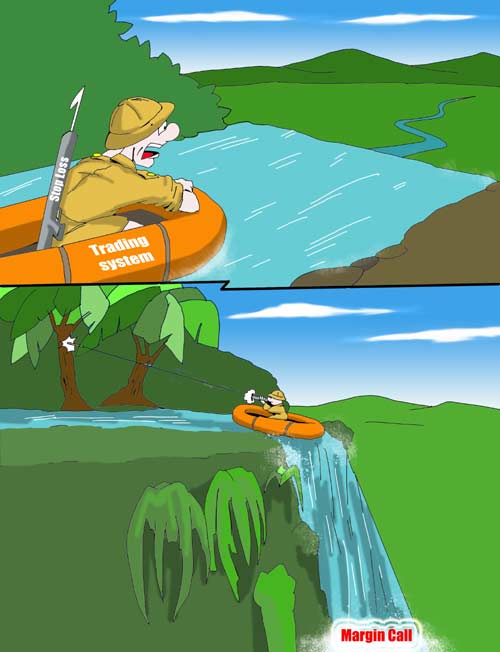Part I. Why Do We Need Stop-Loss Orders?


Right from beginning we have to understand that we do not rule and control the market. Although you might say that this is obvious and it looks like we understand it – we often behave in the opposite way. In fact, every day is a challenge for traders – rumors, news, emergencies, global politics and fundamentals could drive the market fast and furious, and each trader’s ship should survive in this awful market flow, as long as it possible.
As a conclusion we have to understand that every day we can take positions in the wrong direction. This will be unwelcome and unfortunately for us but these sort of losing trades are part of this business. Since not we rule the market. Hence this is a common and natural but not outstanding event and we have to be prepared for that scenario.
Commander in Pips: Actually there are two possible ways to act in this case – cut and stop your losses quickly or hold loss positions with hope that the market will reverse back soon and you will able to make profit or at least exit at breakeven. If the market will not do that then it will probably destroy your account.
We will not talk here about experienced traders, since they trade mostly for profit already and they have accomplished such goals as survival on the market. So they appoint different and greater targets. Here we will talk about newbie traders. As we’ve said already multiple of times, their task in the beginning is mostly to survive or, better to say live to trade. Because as long as they will stay “live” on the market – they will study, gain experience and skew probability of success in their favor. Hence they have to stay strong against any behavior that could decrease “life” on market and by all possible ways decrease the probability of that.
Second important moment is the level of stress. Holding a losing position without stop-loss protection significantly increases its level, especially if day by day you see rising loss level on your position. When this loss reaches some crucial point of your mind – then you can’t think rationally, you can’t switch to another possibility and that position occupies your mind totally. Besides, it occupies it with uncomfortable feelings and thoughts – it occupies it with greater and greater stress. Do you really need it?
Think twice. If you have a properly working trading system you could take small loss on this position and already compensate it doubly with other opportunities. IF you didn’t take this small loss – you didn’t compensate it, since you can’t even think about other opportunities, or think reasonably. This is like domino effect that leads to losses in other trades due to irrational decision making under stress pressure.
As you can see using stop-loss orders is called for double service – limit your loss and reduce stress. Both of them are possible, right? Since we will start to discuss particular ways of stop placement later, here we still have to note about stop loss placement in general.
The major rule for stop loss placement is that it has to be placed at “the point of no return”.
What does that mean? It means that reaching of your stop-loss order by price means:
1. The market totally has erased your initial context and reasons for trading;
2. The market will proceed further against your position with great probability.
As you understand, there can’t exist two “no return” points. By that thought it becomes obvious that estimation of stop-loss “point of no return” comes first, while lot size and entry level comes second and dependable from stop-loss point. We will talk about it in later chapters.
Simple example is some pattern trading. Let’s say that you trade Gartley “222” Sell. Hence, you stop-loss order will be above the high of initial X-A swing. If market will reach it – it will turn invalidate the “222” pattern. If you will place stop somewhere inside the X-A swing, below its high, then it will not be “no return” point or “absolute invalidation point”, since “222” pattern still could work after deeper AB=CD retracement inside of the X-A swing.
And now let’s pass to discussion of particular ways of stop-loss placement.
Comments
Table of Contents
- Introduction
- FOREX - What is it ?
- Why FOREX?
- The structure of the FOREX market
- Trading sessions
- Where does the money come from in FOREX?
- Different types of market analysis
- Chart types
- Support and Resistance
-
Candlesticks – what are they?
- Part I. Candlesticks – what are they?
- Part II. How to interpret different candlesticks?
- Part III. Simple but fundamental and important patterns
- Part IV. Single Candlestick Patterns
- Part V. Double Deuce – dual candlestick patterns
- Part VI. Triple candlestick patterns
- Part VII - Summary: Japanese Candlesticks and Patterns Sheet
-
Mysterious Fibonacci
- Part I. Mysterious Fibonacci
- Part II. Fibonacci Retracement
- Part III. Advanced talks on Fibonacci Retracement
- Part IV. Sometimes Mr. Fibonacci could fail...really
- Part V. Combination of Fibonacci levels with other lines
- Part VI. Combination of Fibonacci levels with candle patterns
- Part VII. Fibonacci Extensions
- Part VIII. Advanced view on Fibonacci Extensions
- Part IX. Using Fibonacci for placing orders
- Part X. Fibonacci Summary
-
Introduction to Moving Averages
- Part I. Introduction to Moving Averages
- Part II. Simple Moving Average
- Part III. Exponential Moving Average
- Part IV. Which one is better – EMA or SMA?
- Part V. Using Moving Averages. Displaced MA
- Part VI. Trading moving averages crossover
- Part VII. Dynamic support and resistance
- Part VIII. Summary of Moving Averages
-
Bollinger Bands
- Part I. Bollinger Bands
- Part II. Moving Average Convergence Divergence - MACD
- Part III. Parabolic SAR - Stop And Reversal
- Part IV. Stochastic
- Part V. Relative Strength Index
- Part VI. Detrended Oscillator and Momentum Indicator
- Part VII. Average Directional Move Index – ADX
- Part VIII. Indicators: Tightening All Together
- Leading and Lagging Indicators
- Basic chart patterns
- Pivot points – description and calculation
- Elliot Wave Theory
- Intro to Harmonic Patterns
- Divergence Intro
- Harmonic Approach to Recognizing a Trend Day
- Intro to Breakouts and Fakeouts
- Again about Fundamental Analysis
- Cross Pair – What the Beast is That?
- Multiple Time Frame Intro
- Market Sentiment and COT report
- Dealing with the News
- Let's Start with Carry
- Let’s Meet with Dollar Index
- Intermarket Analysis - Commodities
- Trading Plan Framework – Common Thoughts
- A Bit More About Personality
- Mechanical Trading System Intro
- Tracking Your Performance
- Risk Management Framework
- A Bit More About Leverage
- Why Do We Need Stop-Loss Orders?
- Scaling of Position
- Intramarket Correlations
- Some Talk About Brokers
- Forex Scam - Money Managers
- Graduation!